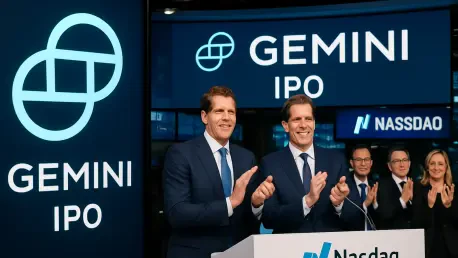In a landscape where digital assets are increasingly intersecting with traditional finance, Gemini, a prominent cryptocurrency exchange founded by Tyler and Cameron Winklevoss, has filed for a U.S. initial public offering (IPO) on Nasdaq under the ticker symbol “GEMI.” Announced on August 15, this move comes at a pivotal moment as the crypto market experiences a significant rebound, with renewed investor enthusiasm and a surge in IPO activity across sectors. This filing not only underscores Gemini’s ambition to cement its place in mainstream markets but also serves as a barometer for the broader cryptocurrency industry’s maturation. The analysis that follows dives deep into the market trends, financial data, and competitive dynamics surrounding this development, offering insights into what this could mean for the future of digital asset exchanges.
Unpacking Market Trends and Projections in Crypto Exchanges
The Surge of Crypto Firms in Public Markets
The cryptocurrency sector has undergone a remarkable transformation over recent years, shifting from a speculative niche to a more structured component of global finance. Gemini’s IPO filing aligns with a growing trend of digital asset companies seeking public listings, following in the footsteps of Coinbase Global, which became the first major crypto exchange to list in the U.S., and Bullish, marking the second. Gemini aims to be the third, tapping into a wave of institutional interest bolstered by favorable policy shifts and significant inflows into crypto exchange-traded funds (ETFs). This trend reflects a market increasingly valuing legitimacy and capital access, with public listings acting as a stamp of credibility for firms navigating a once-unregulated space.
Financial Realities and Competitive Pressures
A closer look at Gemini’s financials, as disclosed in the IPO filing, reveals a challenging picture that could influence market perceptions. For the first half of the current year, the company reported a net loss of $282.5 million on revenue of $68.6 million, a stark contrast to a net loss of $41.4 million on revenue of $74.3 million in the same period last year. These figures highlight the intense competition within the crypto exchange market, where thin margins and high operational costs persist. Compared to giants like Coinbase, which recently earned a spot in the S&P 500, Gemini faces an uphill battle to convince investors of its profitability potential. Market analysts note that the planned use of IPO proceeds for general corporate purposes and debt repayment may not fully address these underlying financial strains.
Regulatory Tailwinds and Strategic Positioning
Amid financial hurdles, the crypto market is benefiting from increasing regulatory clarity, particularly in the U.S., where frameworks like the GENIUS Act have provided a structured approach to stablecoin oversight. Gemini, which issues its own stablecoin, the Gemini Dollar (GUSD), pegged 1:1 to the U.S. dollar, stands to gain from this environment as investors gravitate toward regulated products. However, differentiation remains a critical challenge in a crowded field. While Coinbase dominates in trading volume and brand trust, Gemini must carve out a unique identity, whether through custody services, innovative offerings, or global expansion across its operations in over 60 countries. Market observers suggest that aligning with regulatory trends could be a key driver of long-term success for exchanges willing to adapt.
Global Dynamics and Emerging Threats
The global scope of Gemini’s operations introduces additional layers of complexity to its market position. With varying regulatory approaches to cryptocurrency—from progressive policies in some regions to outright bans in others—the exchange must navigate a fragmented landscape that could impact growth. Furthermore, the rise of decentralized finance (DeFi) platforms poses a direct threat to traditional exchanges by enabling peer-to-peer trading without intermediaries. Current market analysis indicates a shift in investor focus toward sustainability and compliance over short-term speculative gains, a trend that could favor established players like Gemini if they prioritize long-term alignment with regulatory and technological advancements.
Implications and Strategic Pathways Forward
Reflecting on the analysis, Gemini’s IPO filing captures a critical juncture for the cryptocurrency market, highlighting both the opportunities and challenges inherent in transitioning to public markets. The financial struggles underscore a broader reality of competitive pressures and operational costs that many exchanges face during this period. Yet, the regulatory progress and institutional interest that characterize the market offer a promising backdrop for firms ready to innovate and adapt. Moving forward, stakeholders are encouraged to monitor how Gemini leverages its stablecoin offerings and global reach to differentiate itself. For investors, a cautious approach focusing on financial health and compliance is advisable, while businesses in the sector need to prioritize transparency and strategic positioning. This moment serves as a reminder that the path to mainstream acceptance for crypto exchanges requires balancing innovation with stability, setting the stage for a dynamic evolution in the years that follow.









